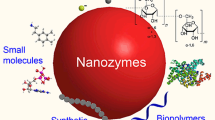Abstract
Natural enzymes as biological catalysts possess remarkable advantages, especially their highly efficient and selective catalysis under mild conditions. However, most natural enzymes are proteins, thus exhibiting an inherent low durability to harsh reaction conditions. Artificial enzyme mimetics have been pursued extensively to avoid this drawback. Quite recently, some inorganic nanoparticles (NPs) have been found to exhibit unique enzyme mimetics. In addition, their much higher stability overcomes the inherent disadvantage of natural enzymes. Furthermore, easy mass-production and low cost endow them more benefits. As a new member of artificial enzyme mimetics, they have received intense attention. In this review article, major progress in this field is summarized and future perspectives are highlighted.
Similar content being viewed by others
References
Breslow R. Biomimetic chemistry and artificial enzymes: Catalysis by design. Acc Chem Res, 1995, 28: 146–153
Wulff G. Enzyme-like catalysis by molecularly imprinted polymers. Chem Rev, 2002, 102: 1–27
Fruk L, Niemeyer C M. Covalent hemin-DNA adducts for generating a novel class of artificial heme enzymes. Angew Chem Int Ed, 2005, 44: 2603–2606
Muche M S, Gobel M W. Bis(guanidinium) alcohols as models of staphylococcal nuclease: Substrate binding through ion pair complexes and fast phosphoryl transfer reactions. Angew Chem Int Ed, 1996, 35: 2126–2129
Aissaoui H, Bachmann R, Schweiger A, et al. On the origin of the low-spin character of cytochrome P450cam in the resting state-investigation of enzyme models with pulse EPR and ENDOR spectroscopy. Angew Chem Int Ed, 1998, 37: 2998–3002
Gao L, Zhuang J, Nie L, et al. Intrinsic peroxidase-like activity of ferromagnetic nanoparticles. Nat Nanotechnol, 2007, 2: 577–583
Wei H, Wang E K. Fe3O4 magnetic nanoparticles as peroxidase mimetics and their applications in H2O2 and glucose detection. Anal Chem, 2008, 80: 2250–2254
Chang Q, Deng K J, Zhu L H, et al. Determination of hydrogen peroxide with the aid of peroxidase-like Fe3O4 magnetic nanoparticles as the catalyst. Microchim Acta, 2009, 165: 299–305
Gao L, Wu J, Lyle S, et al. Magnetite nanoparticle-linked immunosorbent assay. J Phys Chem C, 2008, 112: 17357–17361
Yu F, Huang Y, Cole A J, et al. The artificial peroxidase activity of magnetic iron oxide nanoparticles and its application to glucose detection. Biomaterials, 2009, 30: 4716–4722
Zhang Z, Wang Z, Wang X, et al. Magnetic nanoparticle-linked colorimetric aptasensor for the detection of thrombin. Sens Actuators B, 2010, 147: 428–433
Dai Z, Liu S, Bao J, et al. Nanostructured FeS as a mimic peroxidase for biocatalysis and biosensing. Chem Eur J, 2009, 15: 4321–4326
Perez J M, Asati A, Nath S, et al. Synthesis of biocompatible dextrancoated nanoceria with pH-dependent antioxidant properties. Small, 2008, 4: 552–556
Asati A, Santra S, Kaittanis C, et al. Oxidase-like activity of polymer-coated cerium oxide nanoparticles. Angew Chem Int Ed, 2009, 48: 2308–2312
Kajita M, Hikosaka K, Iitsuka M, et al. Platinum nanoparticle is a useful scavenger of superoxide anion and hydrogen peroxide. Free Radical Res, 2007, 41: 615–626
Kim J, Takahashi M, Shimizu T, et al. Effects of a potent antioxidant, platinum nanoparticle, on the lifespan of Caenorhabditis elegans. Mech Ageing Dev, 2008, 129: 322–331
Hamasaki T, Kashiwagi T, Imada T, et al. Kinetic analysis of superoxide anion radical-scavenging and hydroxyl radical-scavenging activities of platinum nanoparticles. Langmuir, 2008, 24: 7354–7364
Watanabe A, Kajita M, Kim J, et al. In vitro free radical scavenging activity of platinum nanoparticles. Nanotechnology, 2009, 20: 455105
Onizawa S, Aoshiba K, Kajita M, et al. Platinum nanoparticle antioxidants inhibit pulmonary inflammation in mice exposed to cigarette smoke. Pulm Pharmacol Ther, 2009, 22: 340–349
Zhang L, Laug L, Muenchgesang W, et al. Reducing Stress on cells with apoferritin-encapsulated platinum nanoparticles. Nano Lett, 2010, 10: 219–223
He W W, Wu X C, Liu J B, et al. Formation of AgPt alloy nanoislands via chemical etching with tunable optical and catalytic properties. Langmuir, 2010, 26: 4443–4448
He W W, Wu X C, Liu J B, et al. Design of AgM bimetallic alloy nanostructures (M=Au, Pd, Pt) with tunable morphology and peroxidase-like activity. Chem Mater, 2010, 22: 2988–2994
He W W, Liu Y, Yuan J S, et al. Au@Pt nanostructures as oxidase and peroxidase mimetics for use in immunoassays. Biomaterials, 2011, 32: 1139–1147
Zhang K, Hu X N, Liu J B, et al. Formation of PdPt alloy nanodots on gold nanorods: Tuning oxidase-like activities via composition. Langmuir, 2011, 27: 2796–2803
Fan J, Yin J, Ning B, et al. Direct evidence for catalase and peroxidase activities of ferritin-platinum. Biomaterials, 2011, 32: 1611–1618
Jv Y, Li B, Cao R, Positively-charged gold nanoparticles as peroxidase mimic and their application in hydrogen peroxide and glucose detection. Chem Commun, 2010, 46: 8017–8019
Song Y, Qu K, Zhao C, et al. Graphene oxide: Intrinsic peroxidase catalytic activity and its application to glucose detection. Adv Mater, 2010, 22: 1–5
Song Y, Wang X, Zhao C, et al. Label-free colorimetric detection of single nucleotide polymorphism by using single-walled carbon nanotube intrinsic peroxidase-like activity. Chem Eur J, 2010, 16: 3617–3621
Yang C H, Du J J, Peng Q, et al. Polyaniline/Fe3O4 nanoparticle composite: Synthesis and reaction mechanism. J Phys Chem B, 2009, 113: 5052–5058
Author information
Authors and Affiliations
Corresponding author
Rights and permissions
About this article
Cite this article
Hu, X., Liu, J., Hou, S. et al. Research progress of nanoparticles as enzyme mimetics. Sci. China Phys. Mech. Astron. 54, 1749 (2011). https://doi.org/10.1007/s11433-011-4480-0
Received:
Accepted:
Published:
DOI: https://doi.org/10.1007/s11433-011-4480-0




